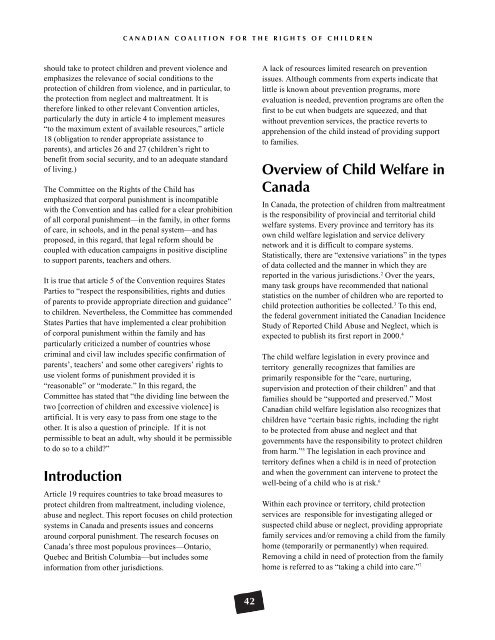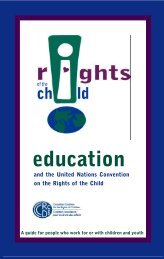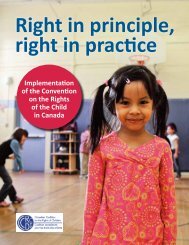Poste - Canadian Coalition for the Rights of Children
Poste - Canadian Coalition for the Rights of Children
Poste - Canadian Coalition for the Rights of Children
You also want an ePaper? Increase the reach of your titles
YUMPU automatically turns print PDFs into web optimized ePapers that Google loves.
C A N A D I A N C O A L I T I O N F O R T H E R I G H T S O F C H I L D R E N<br />
should take to protect children and prevent violence and<br />
emphasizes <strong>the</strong> relevance <strong>of</strong> social conditions to <strong>the</strong><br />
protection <strong>of</strong> children from violence, and in particular, to<br />
<strong>the</strong> protection from neglect and maltreatment. It is<br />
<strong>the</strong>re<strong>for</strong>e linked to o<strong>the</strong>r relevant Convention articles,<br />
particularly <strong>the</strong> duty in article 4 to implement measures<br />
“to <strong>the</strong> maximum extent <strong>of</strong> available resources,” article<br />
18 (obligation to render appropriate assistance to<br />
parents), and articles 26 and 27 (children’s right to<br />
benefit from social security, and to an adequate standard<br />
<strong>of</strong> living.)<br />
The Committee on <strong>the</strong> <strong>Rights</strong> <strong>of</strong> <strong>the</strong> Child has<br />
emphasized that corporal punishment is incompatible<br />
with <strong>the</strong> Convention and has called <strong>for</strong> a clear prohibition<br />
<strong>of</strong> all corporal punishment—in <strong>the</strong> family, in o<strong>the</strong>r <strong>for</strong>ms<br />
<strong>of</strong> care, in schools, and in <strong>the</strong> penal system—and has<br />
proposed, in this regard, that legal re<strong>for</strong>m should be<br />
coupled with education campaigns in positive discipline<br />
to support parents, teachers and o<strong>the</strong>rs.<br />
It is true that article 5 <strong>of</strong> <strong>the</strong> Convention requires States<br />
Parties to “respect <strong>the</strong> responsibilities, rights and duties<br />
<strong>of</strong> parents to provide appropriate direction and guidance”<br />
to children. Never<strong>the</strong>less, <strong>the</strong> Committee has commended<br />
States Parties that have implemented a clear prohibition<br />
<strong>of</strong> corporal punishment within <strong>the</strong> family and has<br />
particularly criticized a number <strong>of</strong> countries whose<br />
criminal and civil law includes specific confirmation <strong>of</strong><br />
parents’, teachers’ and some o<strong>the</strong>r caregivers’ rights to<br />
use violent <strong>for</strong>ms <strong>of</strong> punishment provided it is<br />
“reasonable” or “moderate.” In this regard, <strong>the</strong><br />
Committee has stated that “<strong>the</strong> dividing line between <strong>the</strong><br />
two [correction <strong>of</strong> children and excessive violence] is<br />
artificial. It is very easy to pass from one stage to <strong>the</strong><br />
o<strong>the</strong>r. It is also a question <strong>of</strong> principle. If it is not<br />
permissible to beat an adult, why should it be permissible<br />
to do so to a child?”<br />
Introduction<br />
Article 19 requires countries to take broad measures to<br />
protect children from maltreatment, including violence,<br />
abuse and neglect. This report focuses on child protection<br />
systems in Canada and presents issues and concerns<br />
around corporal punishment. The research focuses on<br />
Canada’s three most populous provinces—Ontario,<br />
Quebec and British Columbia—but includes some<br />
in<strong>for</strong>mation from o<strong>the</strong>r jurisdictions.<br />
42<br />
A lack <strong>of</strong> resources limited research on prevention<br />
issues. Although comments from experts indicate that<br />
little is known about prevention programs, more<br />
evaluation is needed, prevention programs are <strong>of</strong>ten <strong>the</strong><br />
first to be cut when budgets are squeezed, and that<br />
without prevention services, <strong>the</strong> practice reverts to<br />
apprehension <strong>of</strong> <strong>the</strong> child instead <strong>of</strong> providing support<br />
to families.<br />
Overview <strong>of</strong> Child Welfare in<br />
Canada<br />
In Canada, <strong>the</strong> protection <strong>of</strong> children from maltreatment<br />
is <strong>the</strong> responsibility <strong>of</strong> provincial and territorial child<br />
welfare systems. Every province and territory has its<br />
own child welfare legislation and service delivery<br />
network and it is difficult to compare systems.<br />
Statistically, <strong>the</strong>re are “extensive variations” in <strong>the</strong> types<br />
<strong>of</strong> data collected and <strong>the</strong> manner in which <strong>the</strong>y are<br />
reported in <strong>the</strong> various jurisdictions. 2 Over <strong>the</strong> years,<br />
many task groups have recommended that national<br />
statistics on <strong>the</strong> number <strong>of</strong> children who are reported to<br />
child protection authorities be collected. 3 To this end,<br />
<strong>the</strong> federal government initiated <strong>the</strong> <strong>Canadian</strong> Incidence<br />
Study <strong>of</strong> Reported Child Abuse and Neglect, which is<br />
expected to publish its first report in 2000. 4<br />
The child welfare legislation in every province and<br />
territory generally recognizes that families are<br />
primarily responsible <strong>for</strong> <strong>the</strong> “care, nurturing,<br />
supervision and protection <strong>of</strong> <strong>the</strong>ir children” and that<br />
families should be “supported and preserved.” Most<br />
<strong>Canadian</strong> child welfare legislation also recognizes that<br />
children have “certain basic rights, including <strong>the</strong> right<br />
to be protected from abuse and neglect and that<br />
governments have <strong>the</strong> responsibility to protect children<br />
from harm.” 5 The legislation in each province and<br />
territory defines when a child is in need <strong>of</strong> protection<br />
and when <strong>the</strong> government can intervene to protect <strong>the</strong><br />
well-being <strong>of</strong> a child who is at risk. 6<br />
Within each province or territory, child protection<br />
services are responsible <strong>for</strong> investigating alleged or<br />
suspected child abuse or neglect, providing appropriate<br />
family services and/or removing a child from <strong>the</strong> family<br />
home (temporarily or permanently) when required.<br />
Removing a child in need <strong>of</strong> protection from <strong>the</strong> family<br />
home is referred to as “taking a child into care.” 7




